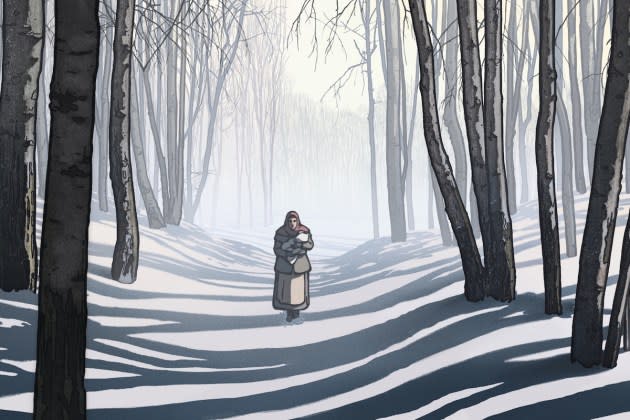‘The Most Precious of Cargoes’ Review: An Animated Fable From the Director of ‘The Artist’ Finds Hope in the Holocaust

Of all the films premiering at Cannes this year, “The Most Precious of Cargoes” is both an anomaly (the first animated feature to compete for the Palme d’Or since “Persepolis” in 2007) and the most likely to become a classic. Blending the heavy lines of early-20th-century woodcuts with the gentle pastels of watercolor painting, “The Artist” director Michel Hazanavicius finds a poignant way to address not only the horrors of the Holocaust, but the kindness that combated it, crafting an indelible parable destined to be watched and shared by generations to come.
The polar opposite of “The Zone of Interest,” his hand-drawn adaptation of the slender but impactful novel by Jean-Claude Grumberg engages audiences at the gut, rather than in some abstract intellectual way. It focuses on neither the culprits nor the victims, but average folk who tried to remain neutral — as if such a thing were possible — until such time as they were obliged to engage.
More from Variety
The main characters here are a poor Polish woodcutter (gruffly voiced in French by Grégory Gadeois) and his wife (Dominique Blanc), simple peasants who harbor antisemitic thoughts without ever speaking the word “Jew.” Over the course of the film, they come to learn (in the woodcutter’s words) that “the Heartless have a heart.” And lest the weight of the material escape a soul, Hazanavicius steers the project into more overtly historical territory in the final stretch, offering haunting images of scared figures huddled on trains and piled in mass graves.
Before things turn heavy, however, “The Most Precious of Cargoes” begins like your typical fairy tale: “Once upon a time …” reads the late Jean-Louis Trintignant. But it could just as easily be an Old Testament story, like that of baby Moses from the book of Exodus, wherein the endangered infant is placed in a basket upon the Nile, only to be rescued and raised by the pharaoh’s daughter. Here, too, a Jewish child is abandoned by its parents and adopted by gentiles, when a father tosses it from the window of a train bound for Auschwitz. They have no way of knowing whether it will survive — and every hope that its fate will be better than their own.
Every day, the woodcutter’s wife prays to the “god of the train” for “a little something from your cargo.” She and her husband have barely enough to feed their starving dog, much less another mouth. Without turning pathetic, the film makes clear that this couple once had a child of their own. So, when the woman rescues a crying babe from the snow, wrapped in a blue-and-white tallit (or Jewish prayer shawl), she instinctively treats it like the one she lost.
During World War II, so much property passed from Jewish hands into those of their oppressors, but this transfer isn’t quite the same. For starters, the woodcutter doesn’t want the child, ordering his wife to return it to the frozen forest. “Their nature is not like ours,” he growls. Considering Hazanavicius’ previous credits (all comedies, except for 2014’s punishingly earnest, Chechnya-set “The Search”), audiences surely expect him to get cutesy with this wide-eyed infant. Instead, the child’s expression hardly moves as the director takes a minimalistic approach.
The movie may be animated, but it’s no conventional cartoon. If anything, it looks like a graphic novel come to life, rendered in thick, dark strokes. The compositions are unexpectedly austere at times, having more in common with William Blake’s more tortured engravings than with the plaintive cat from DreamWorks’ “Puss in Boots.” But there’s heart to the human characters’ behavior, as when the woman barters the baby’s shawl for a cup of goat’s milk from an ornery neighbor (Denis Podalydès), a veteran of the Great War whose face was disfigured by shrapnel. Easily the most touching moment occurs when the woodcutter acquiesces, unable to resist the child’s charms any longer.
Hazanavicius diverges from Grumberg’s literary technique of alternating between the condemned Jewish family and the woodcutter’s wife, focusing more on what becomes of the baby, who passes like a hot potato from one situation to another. Once the woodcutter comes around, he finds it impossible to hide his happiness from his co-workers, which proves dangerous, since these self-described “good patriots” disapprove of his harboring a Jew.
Eventually, the film takes us into the train, where we learn that the child was a twin. Her sibling will face the very horrors she escaped, as will her father, whose round glasses are the only feature connecting the man she last saw to the emaciated figure who stumbles out of Auschwitz after the liberation. For a time, the film loses track of the child, following instead this living skeleton, who collapses on the tracks where he tossed the baby. A family photograph falls from his hand and blows away in the wind — an image closer to the emotional heights of silent cinema than anything in “The Artist.”
The same goes for the finale, which echoes the timeless last scene of Chaplin’s “City Lights” in its own way. Movingly scored by Alexandre Desplat, the tight 80-minute project isn’t based in fact, à la Anne Frank’s “The Diary of a Young Girl,” but it elicits many of the same feelings. These days, it’s so often the antisemites who seem heartless. Hazanavicius’ redemptive fable shows there’s hope for them too.
Best of Variety
Sign up for Variety’s Newsletter. For the latest news, follow us on Facebook, Twitter, and Instagram.

 Yahoo News
Yahoo News 